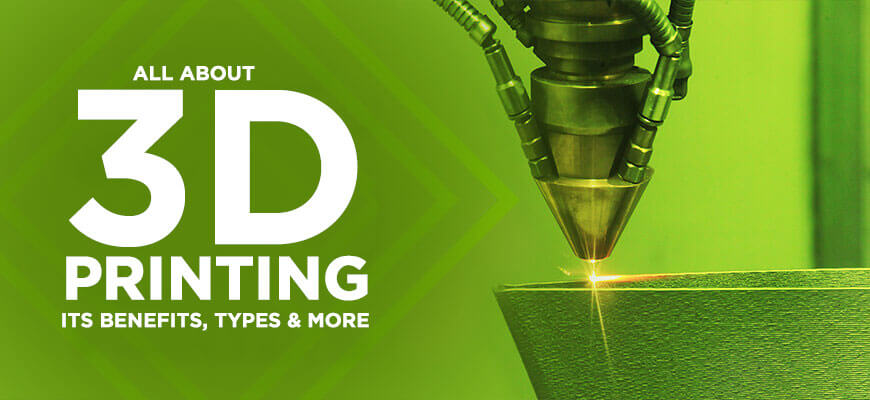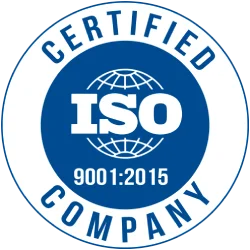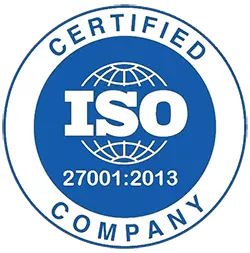All About 3D Printing, Its Benefits, Types & More

3D printing encompasses many forms of technologies and materials and has become an integral part of all the initiatives businesses take today.
Thus, 3D printing has allowed for a great deal of customization in component structures that are designed using CAD software. Not only that, it could even print components that a few complicated production methods cannot produce.
Read this blog till the end as we cover all the basics of 3D printing technology. Keep scrolling!
What is 3D Printing?
3D printing is a kind of additive manufacturing process that can be used to create three-dimensional solid or physical objects from digital 3D model references. This also can be referred as “desktop manufacturing”, “rapid manufacturing”. The process is carried out with the help of addictive manufacturing software programs to produce complex shapes using a limited amount of material.
Here, you need to lay down thin layers of material and combine them to form an object. The materials used can be either in powdered or liquid form and may be metal, plastic, or cement.
The speed of 3D printing is too slow to be used for mass production. However, it is very powerful when it comes to developing prototypes of devices and parts. It can effectively reduce the lead time of production and is very beneficial for small-scale manufacturers.
Types of 3D Printing
When you know about what 3D printing is, now it is important to understand what types of 3D printing are there that are helping businesses various industry verticals in the modern scenario.
-
SLA 3D Printing
Stereolithography, most commonly known by the name SLA 3D Printing, is one of the most profitable techniques when it comes to the additive manufacturing process. It works on a liquid resin layer by layer using a high-powered laser to harden the same. This is done to create the desired 3D shape.
If explained in layman’s language, this process is used to simply convert the photosensitive liquid to 3D solid plastic in the form of layers to get the desired 3D design.
-
SLS 3D Printing
Selective Laser Sintering (SLS) is an other additive manufacturing technique that is used to collect and combine small particles of a polymer or polymer powder to create one solid structure to create a 3D model out of it.
For more than a decade now this technology is the top most choice to create 3D designs by engineers, architects, and even manufacturers. There are three major reasons why it is so popular because these are of low cost that too according to the per part basis, high in productivity and of established material which makes it an ideal for various applications including small-batch, custom manufacturing, rapid prototyping and more.
Benefits of 3D Printing
-
Reduced Machine Costs
3D printing technology helps to bring down the overall product manufacturing cost. Especially when it comes to labor, machines, transit, or materials.
With its help, you can develop complex parts or components in only one step by deploying fewer machines. Even the 3D printers use less energy as compared to large molding machines.
-
Controlling Labor Charges
Hiring more people is not required in additive manufacturing that indeed helps in curbing those extra labor charges. Only a single operator can run the fully automated 3D printer and ultimately saves labor cost.
Apart from this, there is no need to ship products from one country to another or a far-off destination. Instead, you can email the 3d print-ready designs to the desired location.
-
Accelerating the Design Process
It is well-known for its rapid prototyping feature. It means you don’t have to spend weeks creating the prototype. Also, you need not have to go through multiple revisions before finalizing the design.
However, if the situation arises, then you can make the required modifications easily. For this, you do not have to delay the manufacturing process.
-
Less Wastage
Additive manufacturing technology results in producing very little waste as compared to the traditional methods. It is due to the 3D printers, which only use the required amount of material for giving physical shape to the printed model.
Even if waste is generated, the same can be melted and cooled down for reuse.
-
Reduces Storage Space
In traditional manufacturing, it was essential to create parts in bulk to store them for later use. However, in the case of 3D printing, it is not needed.
Three-dimensional printing eliminates the tension of overproduction or extending storage space. It is because the products take less time for creation. So, you can develop them only at the time of requirement.
-
Design Flexibility
Another advantage of 3D printing is that you can use it to create any shape or design. This can be done with the help of minimal software and tools. Also, it may or may not require any modifications in the physical equipment.
On the other hand, the traditional methods need more tools, jig, mold, die, etc. while creating the machine parts.
-
Product Longevity & Sustainability
We have already discussed how 3D printing consumes less energy and produces less waste. It is one of the reasons why it lasts longer and is highly sustainable.
Apart from this, the materials used here are recyclable, hence environment-friendly. Also, the products developed are lightweight and can be customized with the highest precision.
-
Diversified Use of Raw Materials
Combining diversified raw materials is another part of manufacturing. It involves huge expenses and can be a little difficult to achieve traditionally.
However, 3D printing overcomes those limitations. It allows access to mix various materials, which can be used to serve multiple purposes.
-
Time Optimization
With 3D printing, you can manufacture products significantly quicker than the traditional methods. This can save a lot of time. You only have to develop the CAD models, after which any complex shape can be printed quickly.
In this method, there is no need for lengthy prototyping. Here, designs can be tested and verified within a short span.
-
Gaining A Competitive Edge
Using this technology, you can accurately demonstrate the product models to the clients without the fear of miscommunication. It also enables you to carry out cost-effective testing of the products. It will help them to get acceptance in the market.
Furthermore, you can customize it to enhance its uniqueness and give it a competitive edge.
-
Eliminating Errors
Having more steps is very common in conventional methods. It can add the risk of getting errors. It is because there might be a possibility to miss out on a step in between. But, in 3D printing, products can be manufactured in a single step along with quick verification of designs. It results in the error-free creation of products and parts.
-
Mitigating Risks
The technology also provides designers with the advantage of risk mitigation in manufacturing. It means that they can verify the design of the product prototype before investing in high-priced manufacturing tools, jigs, or molds.
This eventually saves their time, money, and efforts while boosting their confidence to invest in large projects.
-
Safeguarding Intellectual Property
Project confidentiality won't be a problem when it comes to additive manufacturing. Here, your designs cannot be stolen or claimed by third-party users.
It is because the 3D printers will be undergoing continuous prototyping or manufacturing work. It will ensure that they won't leave the company and hence, designs will remain in-house.
-
Freedom of Customization
Freedom of design customization is another point that makes the technology reliable. Many businesses have embraced this concept to produce customized parts and components of the products.
It helps shape the proof of concept and provides endless possibilities to develop new ideas.
-
Ensuring High Customer Satisfaction
Customer satisfaction is highly important for the success of any business. As you can deliver the products as per their exact demands, they will remain satisfied with your brand. Besides, staying ahead of the competition and quick manufacturing of products at a cheaper rate will also help in increasing their satisfaction levels.
Bonus read: How to Prepare Your Model for Flawless 3D Printing?
Materials used in 3D printing
As the applications of 3D printing continue to grow massively, so does the types of materials used to suit the various needs of industries and other sectors. Here are some of the most common materials used in 3D printing:
-
Plastics
Out of all the materials used in 3D printing, plastic is the most common material used for printed toys and household fixtures. They are generally made by melting the thermoplastic filament and molding it into shape. The most popular one is Acrylonitrile Butadiene styrene (ABS), which is strong and durable. It is widely used for castings, fixtures, and other end-use parts.
-
Resins
Resin is one of the less-used materials in 3D printing nowadays. It involves various technologies like SLA (Stereolithography), DLP (Digital Light Processing) and CLIP (Continous Liquid Interface Production) to create smooth solid objects. Resins can be of various types, such as castable, rigid, flexible, etc. The primary purpose of the resin is that it can be used in many applications as it has high chemical resistance and the materials are rigid and delicate.
-
Stainless Steel
Compared to the 3D printing material, Stainless Steel is the second-most popular material used. It is operated through a process called direct meta-laser sintering (DMLS). Many manufacturers widely use this technique to speed up and simplify parts production. The primary reason to choose steel is that it is robust, fatigue-resistant, and highly affordable. It is used in high-pressure, high-temperature environments by engineers and other scientists.
-
Powders
Most of the engineers use powdered materials to construct products. The most commonly used material is nylon, which is also known as polyamide. It is one of the best-known 3D printing filaments due to its flexibility, durability, and low friction. The powder is primarily melted and then processed in layers until the desired shape is achieved. It is suitable for printing durable parts, making it a popular choice for printing prototypes.
-
Ceramic
Ceramics is the newest material used in 3D printing. It has a superior ability to withstand extreme pressure than metals and plastics. It is highly durable and possesses electrical and thermal conductivity. This type of material is used in Binder Jetting technology to make fragile and fine objects. The are several types of ceramic available such as aluminium oxide, zirconium oxide, aluminium nitride, silicon carbide, and nitride, etc.
3D Printing Process
Unlike traditional printing processes, 3D printing requires fewer steps, enabling you to print more efficiently. Generally, the steps involved are CAD modeling, generating STL files, slicing, printing, and post-processing.
-
CAD modeling
Modeling refers to drawing a model of the object using the software. The digital models can be created with 3D modeling software, namely CAD software. The resulting digital model can be printed on a 3D printer. This helps the users to create simulations of how objects look in the real environment. In this step, the model you design, scan is what your 3D printer will produce.
-
Generating an STL file
The obtained digital models are in the CAD file and are now converted to the STL file format. Standard Tessellation Language (STL) files are needed in the printing process as they describe the surface and shape of the 3D model. Once the STL file is complete, it is sent to the printer. The 3D printer-compatible format has a set of instructions that will instruct the printer on where to construct the final object.
-
Slicing
The next step is the slicing process for printing the model. Many slicing programs are available, but the most commonly used one is Slicer. The slices are called layers where the 3D model is sliced into multiple layers placed above each other. The slicing software gives the instructions to the printer through G-code, and the printer understands them, and the slices are deposited on the printer.
-
3D printing
Once the slicing is complete, it is sent to the printer. Before printing, ensure your machine is set up correctly like the plate is clean, dry, and has no material residue. It is the simplest step where the material is loaded, the STL file is uploaded to the printer, and the printer prepares to print the final object. During this printing process, the filaments are accumulated layer by layer and monitored for progress.
-
Post-processing
It is the final stage of the 3D printing process. The printed object must be removed from the bed once the printer completes and comes to a halt. There are various technologies involved in this process. Generally, it consists in brushing off any remaining powder or washing the printed object. Some of the prints require some time to cure, like resin printing. In this case, the wasted resin is washed off carefully, and ensure to wear gloves and also that the print doesn't break.
Future advancements in 3D printing
-
3D Bio-printing
3D bio-printing is the method that uses bio-inks to imitate functional tissues and organs. This technique has not only developed in organ replacement, but it also serves as an in vitro model for medical sectors. They are mainly using inkjet, laser, and pressure-based bio-printing. This method works by making the bio inks, with which the tissues are printed, and then making the interactions among the cells. As we know, 3D bioprinting has been widely used in tissue generation and is used for drug development and safety. In the future, bioprinted bones could be created, organ transplants for humans could be done, living cells could be generated, etc., to improve patient outcomes.
-
3D Metal Printing
It is one of the fastest-growing segments in 3D printing. Most manufacturers use this technology in the automotive, industrial goods, and energy sectors as advanced solutions. An FDM printer is used in today's metal printers to print the models. Metal 3D printers are widely used for producing complex parts. In the future, you can see the rise in the aerospace industry and other manufacturing sectors where the combination of speed and resolution will be higher in the production of finished parts.
-
Large-Scale 3D Printing
This is one of the most significant advancements in 3D printing. Large-scale 3D printing is used to print several feet in size objects. Most industries, like aerospace, architecture, automotive, and other engineering sectors, use this technique to produce large and complex parts. In the future, it will reduce manufacturing costs as it produces thousands of large parts every day.
Conclusion
With the help of this 3D printing technology, you can significantly lower your production costs, storage-related expenses, and other overheads and along with that there are many more benefits that can be achieved by the businesses if this technique is used correctly.
Besides, manual intervention can also be lessened while eliminating potential errors. Thus, by fine-tuning this technology, you can get more robust and versatile results for various applications. Also mastering this technology is not very technical, with some efforts and professional guidance one can easily be a master of the same, however there are multiple 3D modeling vendors available that serve the best 3D print design services and even guide you with the best options to choose from.
Want 3D print model design solutions?
Get in Touch With Us

